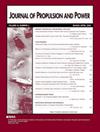Modern Competing Flames Model for Composite Ammonium Perchlorate/Hydroxyl-Terminated Polybutadiene Propellant Combustion
IF 2.4
4区 工程技术
Q2 ENGINEERING, AEROSPACE
引用次数: 0
Abstract
The competing flames model, also termed the Beckstead–Derr–Price model, for steady-state heterogeneous propellant combustion has been widely used but has not been sufficiently updated in decades or compared to modern propellant combustion databases. In the current study, historical competing flames modeling approaches were thoroughly documented; and an improved framework was outlined and updated to include several improvements, such as variable flame temperatures, specific heat capacities, and latent heat terms. Model parameters were initially taken from previous literature, but the fuel and diffusion flame parameters were optimized based on a compiled database of unimodal propellant burning rates from the literature spanning a wide range of ammonium perchlorate (AP) particle sizes ([Formula: see text]), AP mass concentrations (70–87.5%), and combustion pressures (0.7–20.7 MPa). The improved model was compared to AP monopropellant, unimodal, and multimodal propellant burning rate databases from the literature. General dependencies of the burning rate-to-oxidizer concentration and size were accurately captured. The predictive capability of the improved model for AP monopropellant burning rates and unimodal propellant formulations was excellent, where the only significant discrepancies were noted for very fine AP particles ([Formula: see text]). Model predictions for multimodal formulations were moderate and could be improved by alternative pseudopropellant apportionment and statistical accounting schemes.高氯酸铵/端羟基聚丁二烯复合推进剂燃烧的现代竞争火焰模型
稳态非均质推进剂燃烧的竞争火焰模型,也称为Beckstead–Derr–Price模型,已被广泛使用,但几十年来尚未得到充分更新,也未与现代推进剂燃烧数据库进行比较。在目前的研究中,对历史上的竞争火焰建模方法进行了全面的记录;并对改进后的框架进行了概述和更新,包括一些改进,如可变火焰温度、比热容和潜热项。模型参数最初取自以前的文献,但燃料和扩散火焰参数是基于文献中的单峰推进剂燃烧率数据库进行优化的,该数据库涵盖了高氯酸铵(AP)的各种粒度([公式:见正文])、AP质量浓度(70–87.5%)、,和燃烧压力(0.7–20.7 MPa)。将改进的模型与文献中的AP单组元推进剂、单峰和多峰推进剂燃烧速率数据库进行了比较。准确地捕捉了燃烧速率与氧化剂浓度和大小的一般相关性。改进模型对AP单组元推进剂燃烧速率和单峰推进剂配方的预测能力非常好,其中只有非常细的AP颗粒存在显著差异([公式:见正文])。多模式配方的模型预测是适度的,可以通过替代的伪推进剂分配和统计核算方案来改进。
本文章由计算机程序翻译,如有差异,请以英文原文为准。
求助全文
约1分钟内获得全文
求助全文
来源期刊

Journal of Propulsion and Power
工程技术-工程:宇航
CiteScore
4.20
自引率
21.10%
发文量
97
审稿时长
6.5 months
期刊介绍:
This Journal is devoted to the advancement of the science and technology of aerospace propulsion and power through the dissemination of original archival papers contributing to advancements in airbreathing, electric, and advanced propulsion; solid and liquid rockets; fuels and propellants; power generation and conversion for aerospace vehicles; and the application of aerospace science and technology to terrestrial energy devices and systems. It is intended to provide readers of the Journal, with primary interests in propulsion and power, access to papers spanning the range from research through development to applications. Papers in these disciplines and the sciences of combustion, fluid mechanics, and solid mechanics as directly related to propulsion and power are solicited.
 求助内容:
求助内容: 应助结果提醒方式:
应助结果提醒方式:


